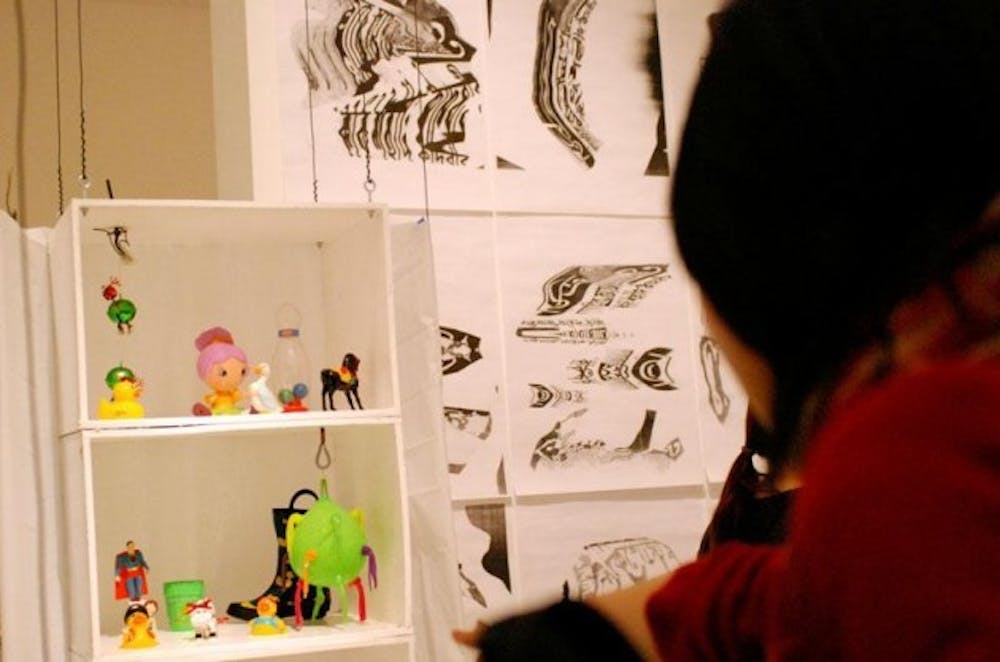The man sitting open-legged on the small stool is eating noodles from a takeaway box.
The stagnant and lingering smell fills the air and clings to the room. People circle around him; they write notes on strips of paper and place them in a brown paper bag that sits in front of him.
He doesn't try to spark conversation with his audience; he doesn't nosily peek at what they're writing - he eats his noodles. He is art. The audience is art. Everything is art.
The Visual Arts Gallery in UB's Center For the Arts has been transformed into an interactive playground of art. The "Yoko Ono Fan Club" exhibit has filled the space.
The exhibition revolves around the Fluxus art movement. Created in the later 1950s, Fluxus is a movement that strives to be accessible and interactive for all - it consistently works for the audience, not against it. Fluxus challenges the perception of art and life within the movement; the two are connected undeniably and unbreakably.
Julie Rozman, the curator of "Yoko Ono Fan Club", believes that the exhibit is both visually and conceptually engaging.
"The result is to raise questions about the boundary between art and not-art, to trouble the way we like to draw a line between art and life." Rozman said.
Despite the titling of the show, Yoko Ono is only one of the artists who contribute to the exhibition.
Artists from around the world were invited to send their work to Buffalo to be put in front of the artistic jury. The best submissions are now on display, many of which hail from Western New York.
One of the most captivating installations was "Wish Piece II (mending), after Yoko Ono" by Marissa Lehner, an artist working and teaching in Buffalo.
The audience walked around the hanging sculptures, mesmerized by the fine strings that connected them all. Audience members were encouraged to become part of the art by moving the strings that held the pieces together. Throughout the evening, certain elements of the work were isolated. The connections were then rebuilt again.
"Fluxus is totally new to me," Lehner said. "When I saw the call for work, I just started to research it a little bit and I immediately connected with this idea of a piece having an instruction or a baseline for which the audience or participants would become a part of the piece and have a hand in that."
The velocity of the exhibition grew as the evening progressed. The audience members launched balloons across the room, they fixed gloves atop empty bottles on the snack tables and eventually, became the art itself.
Mitchell Krumm, a freshman studying fine art, noted that exhibition filled the room.
"I love how the whole room is used," Krumm said "There's no space, even though it's a huge room. I just think every artist used the space from the ceiling down."
Among the scattered objects and the food-turned-art were substantial, pre-made pieces.
Located in the center of the room was a computer loaded with WChess 2000 Online, installed by the artist Devin Wilson; a sign read "Please play! Games are stored online, and may take a moment to load."
Behind Wilson's installation stood a piece that resembled a carnival game - the audience was invited to take a water pistol and shoot down toys from a shelf.
The room was an emblem of chaotic order.
"Interaction is embedded in Fluxus," Rozman said. "Being in a gallery and being invited to do something, touch something, can be a big surprise. You get engaged in a very immediate, corporeal way; you're allowed to have fun...For this kind of art, the participation is meant to become part of the piece."
The boundaries between art and non-art are being broken; Fluxus is serious, but its experience is fun.
Although the exhibits were separate, the art and the artists created a room that worked together in unison. There was no standout piece, but the exhibition as a whole stood out from the mundane preconception of an art gallery.
"Installations have some kind of lifespan to them," Lehner said. "They go up and then they come down ... I always love this idea that they're like nature and they evolve."
The room evolved as one.
"I like it as a space - you walk around and it's informal," said Chase Conatser, a senior English major. "The artwork is at a conceptual and inviting level, so you can interact with the space how you'd like and enjoy it."
The exhibition will run in the CFA until March 29, when there will be a closing performance. Performances will include scores and work from Wooden Cities and BuffFluxus.
Like the string that connects Lehner's sculptures, each audience member will take a different course throughout the lifespan of the exhibition.
Fluxus is there to be molded and played with - go play.
email: arts@ubspectrum.com





